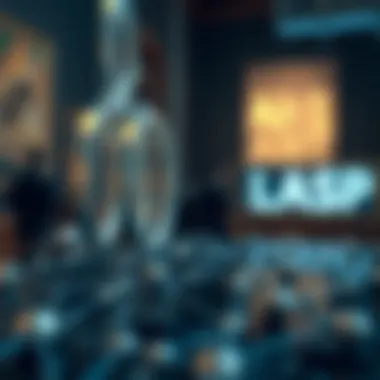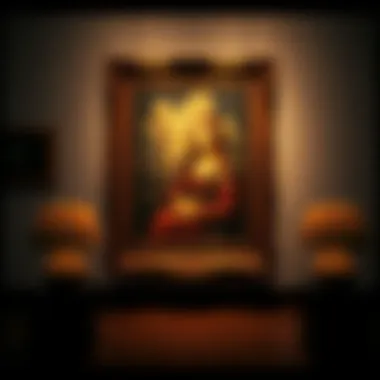Exploring Tokenized Art: Impact on Ownership and Creativity


Intro
The art world has seen significant transformation over the decades, but none quite like the shift brought about by tokenized art via blockchain technology. This novel approach is not just adding a layer of complexity; it's fundamentally reshaping the way we perceive ownership and creativity in the art sphere. In a landscape where digital assets reign supreme, understanding tokenized art can open massive doors for both investors and creators alike.
Tokenization speaks to the heart of ownership, allowing pieces of art to be fractioned into multiple parts, making it accessible to a broader audience. It is an innovation that could change the dynamics of the art market and democratize access to investments that were formerly reserved for the elite few. In this exploration, we will dissect how these blockchain-driven transformations are influencing the very fabric of art creation and exchange.
As we navigate through this article, expect a thorough investigation into key concepts in cryptocurrency, as well as emerging trends and technologies redefining the field of tokenized art.
Key Concepts in Cryptocurrency
Definition and Importance
At its core, cryptocurrency refers to a digital or virtual form of currency that uses cryptography for security. What makes it stand out is its decentralized nature, often associated with blockchain technology. In the context of art, cryptocurrency serves as both a currency for transactions and a vehicle for the facilitation of tokenized assets. This realm is important not just for investors looking to diversify their portfolios but for artists seeking innovative ways to sell their work.
Blockchain Technology Overview
Blockchain technology is a decentralized ledger that ensures transparency and security in transactions. When an artwork is tokenized, its details are stored on a blockchain, offering an immutable record of ownership and provenance. Thus, anyone interested in purchasing a piece can easily verify its authenticity and history.
For instance, when an artist decides to create a non-fungible token (NFT) representing a digital artwork, they can link that NFT to several platforms, boosting its visibility and market potential. The fusion of art and technology paves the way for a new level of interaction between creators and collectors.
"Tokenized art isn't just a trend; it's a revolutionary shift in how we define art ownership and creativity."
Trends and Innovations
Emerging Cryptocurrencies
With the rise of tokenized art, new cryptocurrencies have begun to carve their niches. Some examples include Ether, which powers the Ethereum blockchain where many NFTs are minted. Others like Tezos and Flow have also emerged, catering specifically towards artists and collectors. This diversification reflects the innovation and competition within the market, providing various avenues for both creation and investment.
Technological Advancements in Crypto
The crypto landscape is ever-evolving, paralleling the advancements in blockchain tech. For example, Layer 2 solutions like Polygon aim to provide faster and more affordable transactions for artists and buyers alike. These solutions tackle the scalability issues faced by many blockchains. Moreover, platforms integrating AI with blockchain technology are also emerging, giving artists new tools for creativity and unfortunately sometimes complicating copyright matters.
Understanding these trends can provide valuable insights into the future of tokenized art and help navigate investors toward lucrative opportunities.
In summary, this overview underscores the intersection of blockchain and art, revealing a dynamic environment ripe for exploration. As the art world becomes increasingly intertwined with technology, letting this blend of creativity and innovation flourish will undoubtedly yield a new era of artistic endeavor.
Understanding Tokenized Art
The concept of tokenized art is quite the revolutionary shift in the art market, bringing forth a blend of creativity and technology that many artists and collectors had only dreamed of previously. This understanding isn’t just for artists or tech enthusiasts; it’s crucial for anyone engaged in the realms of investment and culture. Grasping the fundamentals of tokenized art means diving into how art is not only created and bought but how ownership is fundamentally transformed.
The importance of understanding tokenized art goes beyond mere appreciation; it’s about recognizing the myriad ways digital assets can redefine ownership and interaction within the art community. As the lines between the physical world and digital interactions blur, tokenization introduces a unique vantage point from which to view and engage with art. Here, we can explore the benefits and considerations surrounding this innovative trend.
Defining Tokenization
Tokenization embodies the process of converting rights to an asset into a digital token that lives on a blockchain. In terms simplest, you can think of it as creating a digital certificate that verifies ownership, authenticity, and provenance. This digital certificate is immutable, meaning it cannot be altered or deleted, providing a robust framework for artists and buyers alike.
The transition from traditional forms of ownership involves several key facets:
- Digital Ownership: Unlike physical art, which can be subject to loss, theft, or damage, tokenized art leverages blockchain technology to provide a secure representation of ownership.
- Provenance Tracking: Every transaction is permanently recorded, allowing buyers to trace back through all previous transactions and authenticate the work.
- Fractional Ownership: Tokenization allows for dividing a piece of art into multiple tokens, enabling investors to buy a fraction of a high-value piece, hence democratizing art investment.
This definition also raises some practical considerations. Not every piece of art can be tokenized nor should it be. Factors like the medium, nature of the work, and even the artist's stage in their career can affect the viability of tokenization.
The Art of Digital Ownership
The evolution of ownership brought by tokenization challenges several long-held notions about art. In a world where digital copies of artworks can spread like wildfire, being able to stake claim on a unique piece becomes increasingly significant. Digital ownership isn’t merely a claim; it's a digital badge of honor, demonstrating authenticity and exclusive rights to a work that can be easily validated through the blockchain.
Artists gain empowerment through tokenized ownership as they can receive direct compensation from every sale or transfer of their work via smart contracts, which autonomously manage transactions on the blockchain. This autonomy ensures that artists benefit not just once, but potentially multiple times over their career.
Moreover, this shift also influences the relationship between art and the audience. Collectors now not only own a piece, but they become part of its digital footprint, sharing, transferring, or even reselling with a click. It’s an interactive experience that builds community around art, as people can show off their collections with a level of security previously unattainable.
In summary, understanding tokenized art provides clarity on emerging trends and offers opportunities that were once barely imaginable. For marketers, investors, tech professionals, and artists alike, engaging with tokenized art means engaging with the future of creativity itself. As the landscape continues to evolve, so too does the need to grasp these changes that could redefine art as we know it.
Blockchain Technology and Art
Blockchain technology serves as the backbone of the tokenized art uprising, reshaping various facets of how art is created, owned, and traded. The technology inherently offers a decentralized and transparent way to track ownership and provenance, which is crucial in a world where art forgery and misattribution can lead to significant losses. This section will delve into how these systems are not just tools, but transformative agents in the art market.
How Blockchain Records Art
At its core, blockchain functions as a distributed ledger, ensuring that every transaction is recorded in a way that is both secure and immutable. Each piece of art, when tokenized, is assigned a unique digital identifier stored on the blockchain. This identifier corresponds to a non-fungible token (NFT) that contains comprehensive data about the artwork, including details of its origin, ownership history, and transaction records.
- Decentralization: Unlike traditional systems, blockchain removes the need for a central authority to verify transactions. This reduces fees and potential conflicts caused by intermediaries, providing artists and collectors more autonomy.
- Provenance Tracking: Easily accessible provenance records help buyers ensure they acquire genuine art, which strengthens trust in the market. Artists can also take pride in their work's transparent history.
- Security: The data on a blockchain is cryptographically protected, making it virtually impossible to alter or hack. This level of security mitigates fears surrounding digital art theft or counterfeiting.
According to an article on Investopedia, blockchain's ability to store data securely while remaining open for public access underpins its effectiveness in the art world. The technology itself does not exhibit biases, making it an equal player for all stakeholders involved.


Smart Contracts in Art Transactions
Smart contracts represent a game-changing innovation in art transactions, operating on blockchain to auto-execute agreements once predetermined conditions are met. This eliminates the need for intermediaries, thereby facilitating smoother and faster dealings.
- Automated Transactions: These contracts automatically carry out transactions when specific conditions are fulfilled, making art sales more efficient. For instance, when a buyer purchases an artwork through a smart contract, the payment is processed while the digital token is transferred without any manual involvement.
- Royalty Mechanisms: One of the most groundbreaking functions of smart contracts is the ability to program royalties into art sales. This means artists can receive a percentage each time their work is sold in the secondary market, creating a sustainable revenue model that traditional sales models lack.
- Global Reach: Smart contracts also facilitate international transactions by reducing complexities often associated with currency exchanges or jurisdictional laws for art sales. Artists and collectors can engage on a global scale without the added cost or compliance challenges of traditional frameworks.
"With the rise of smart contracts, the art world is witnessing a notable shift towards transparency and equitable profit-sharing, meanings artists will no longer be left in the shadows of their work's value."
Overall, blockchain technology not only registers the art but also enhances transactions through smart contracts, aligning the interests of artists and collectors. As this technology evolves, its impact on the artistic landscape becomes unmistakably clear, bridging gaps that have long existed in the traditional art market.
The Evolution of Ownership
The evolution of ownership in the context of tokenized art marks a pivotal shift in not just how art is created, but also how it is perceived in the digital landscape. This change is crucial as it allows artists, collectors, and investors to redefine their relationships with art. The traditional notion of ownership, which often hinges on physical possession and exclusivity, is flung open to new interpretations. We now live in a world where digital works can have tangible value, and the implications are profound. Ownership now implies more than just possessing an object; it signifies an intricate web of rights, connections, and opportunities brought forth by blockchain technology.
One of the most significant elements of this evolution is the access it grants to a broader audience. Tokenization democratizes ownership, allowing even those with limited resources to own a fraction of a beloved piece. This new model can enable average individuals to invest in high-value art, creating a diverse and vibrant art marketplace.
Potential benefits of this evolution can be outlined as follows:
- Increased Access: More people can partake in art investment, not just the wealthy elite.
- Enhanced Provenance: Tokenization provides a transparent history of ownership, ensuring authenticity and reducing forgery risks.
- Liquidity: Fractional ownership can increase the liquidity of art, allowing for easier buying and selling.
- Empowerment: Artists gain more control over their work and its distribution through smart contracts.
Yet, this new approach comes with its own set of considerations. For one, the shift from tangible to digital makes it essential to engage critically with the nature of value and worth in an ever-changing market. It raises questions regarding intellectual property rights that demand careful navigation. Additionally, the question of accessibility goes beyond financial aspects. As new platforms crop up, ensuring that they are user-friendly and inclusive remains a pressing concern.
The transformation of ownership is not merely an economic phenomenon; it is a cultural revolution. It's about redefining what it means to own art in a digital age. This circles back to the very essence of creativity itself. How do we foster a communal artistic environment while protecting individual rights? This is the crux of the discussion—optimizing ownership in the art world today.
New Models of Malwing
The rise of tokenized art has led to innovative models of engaging with and creating art – a phenomenon some refer to as "malwing" which seeks to blend the creativity of art with the technicality of blockchain. This newly emerged model shifts away from the sole focus on the artist towards collective involvement, introducing a collaborative approach to art-making. Artists can draw from an expansive pool of ideas, utilizing techniques and influences from various creators, thereby enriching their work.
In this new milieu, uniqueness seems to be at odds with the collaborative nature. The concept might appear paradoxical: artists are expected to innovate while collectively drawing from external inspirations. However, this confluence sparks a vibrant dialogue around authorship and originality, reshaping our understanding of artistic creation.
Fractional Ownership and Its Implications
Fractional ownership in tokenized art revolutionizes the way art collectors think about their investments. Instead of needing a hefty sum to acquire a piece, they can now buy a fraction of a digital artwork, thus lowering the barrier to entry significantly. It’s akin to where one can own a piece of the proverbial pie without having to purchase the entire bakery.
Implications of Fractional Ownership:
- Investment Equality: Individuals from various socio-economic backgrounds can invest.
- Decentralized Marketplaces: Platforms enabling fractional ownership can foster diverse marketplaces, free from traditional gatekeepers.
- Subsequent Sales: Asset liquidity increases as more owners are willing to sell their fractions, thus enhancing market dynamics.
However, fractional ownership is not without its challenges. The legal framework remains murky, leading to potential disputes over ownership rights. Moreover, the question of value arises—how does one assign a fair price to fragmented ownership?
Impact on Artists and Creators
The rise of tokenized art has presented a seismic shift in how artists and creators operate within the traditional frameworks of the art world. Beyond mere financial benefits, this modern approach is redefining the relationship between artists, their work, and their audiences. Through the lens of tokenization, the potential for empowerment, engagement, and even challenges comes into sharper focus, reflecting the diverse landscape artists must navigate today.
Empowering Independent Artists
In an era when independent artists frequently face hurdles against established institutions, tokenized art emerges as a beacon of possibility. By leveraging blockchain's capabilities, these creators can directly engage with their audience, removing the barriers typically imposed by galleries and auction houses.
- Direct Sales: Artists can sell their work directly to collectors through platforms like OpenSea, ensuring they receive a fair share of the profits. This crowds out middlemen who traditionally take a cut, often leaving artists with a mere fraction of the sale price.
- Royalty Mechanisms: Smart contracts can be designed to ensure artists earn royalties on subsequent sales, a feature that fundamentally changes how they perceive the value of their work. This persistent income stream can alleviate the pressures of financial instability many creatives face.
- Global Exposure: Tokenized platforms democratize access to art, enabling artists from all corners of the world to showcase and monetize their creations without geographical limitations. A digital artist in a small village can now be seen and appreciated globally, all thanks to tokenization.
Ultimately, the empowerment felt by independent artists is not merely a financial revolution—it's an acknowledgement of their creative voices and the unique stories they bring to the artistic narrative.
Challenges Faced by Traditional Creators
Despite the illuminating advantages tokenization offers, not all artists feel ready to embrace this new medium. Traditional creators often grapple with significant challenges when confronted with the world of tokenized art.
- Adapting to Technology: For established artists rooted in conventional methods, the tech-heavy landscape of tokenized art can feel daunting. There’s a learning curve associated with blockchain technology, and not every creator possesses the technical know-how or resources to navigate this shift effortlessly.
- Market Understanding: The speculative nature of the cryptocurrency market can create confusion. Seasoned artists may not be accustomed to the volatility associated with digital assets, and it might deter them from engaging fully with tokenization. This confusion could lead to missed opportunities or potential pitfalls if not approached with a clear strategy.
- Cultural Resistance: There's a palpable skepticism circles around tokenized art, especially from long-standing galleries and art critics who view blockchain as a passing trend rather than a legitimate component of the art ecosystem. This skepticism can create an environment where traditional artists feel alienated, compelling them to choose sides in a rapidly evolving landscape.
As the lines blur between the digital and tangible art worlds, embracing these changes might well be the difference between thriving and merely surviving in the art community.
In summation, the impact of tokenized art on artists and creators cannot be overstated. While the opportunities are plentiful, the accompanying challenges require thoughtful navigation. As the art world continues to evolve, how creators choose to adapt will shape the future of artistic expression itself.
Market Dynamics of Tokenized Art
The field of tokenized art stands at the confluence of technology and creativity, altering the way artwork is bought, sold, and perceived in the modern economy. Understanding the market dynamics of tokenized art is crucial, as it lays bare the unique opportunities and challenges that artists, collectors, and investors face in this evolving landscape. With the rise of decentralized platforms and innovative pricing models, the traditional art market is undergoing a seismic shift.
The importance of examining market dynamics in tokenized art can be distilled into a few pivotal elements. First and foremost is the idea of accessibility. Tokenization democratizes access to art ownership, allowing individuals who might have been previously priced out of the market to invest in art fractions or tokens at a lower entry point. This shift opens up new narratives about who can be an art owner, particularly among younger generations who are more inclined to engage with digital assets.
Moreover, the concept of provenance—an art piece's history of ownership—takes on new meaning in this context. Blockchain technology ensures that the ownership record is secure and transparent, creating a trust factor that was often missing in the traditional market. This increased security around ownership can lead to higher valuations, as buyers are more confident in the legitimacy of their purchases.
In addition, the interplay between scarcity and digital reproduction deserves attention. Traditionally, scarcity is a driving force in the art market. With digital art, this scarcity is achieved through tokenization, which often limits the number of copies or editions available. As a result, artists can maintain control over their work and determine its value.
Emerging Platforms for Trade
Various platforms have emerged, reshaping how art is sold and traded in the digital age. Websites like OpenSea and Rarible allow artists to mint their artwork directly as NFTs, while buyers can engage with these unique digital items without the layers of intermediaries typical in traditional galleries. Some platforms, such as Foundation, even curate art collections, bringing attention to emerging talent and offering a more refined art-buying experience. This shift challenges the established gallery system, which often favored those already entrenched in the art world.


Furthermore, the growing interest in decentralized finance (DeFi) creates a new backdrop for art trading. Artists and collectors can tap into liquidity pools, facilitating loans secured against their art holdings, thus democratizing traditional forms of financing.
"The rise of new platforms not only reflects changing consumer behaviors but also sets the stage for innovation in how art is conceptualized and monetized."
Price Volatility and Art Valuation
Price volatility is a double-edged sword in the realm of tokenized art. While the potential for rapid price appreciation can appeal to investors, it also introduces a layer of uncertainty. Digital art, often characterized by its unique selling propositions as non-fungible tokens, can see drastic price fluctuations based on market sentiment and trends.
Multiple factors contribute to this volatility. The nascent nature of the tokenized art market means that it is still finding its footing. As more collectors and investors dive in, we're likely to witness cycles of hype and subsequent corrections. The speculation surrounding the next big artist or piece creates an environment ripe for both opportunity and risk.
To navigate these turbulent waters, a more sophisticated understanding of valuation is needed. Unlike traditional artworks that often rely on art historical merit, tokenized art valuations can be influenced by community engagement, social media presence, and even the artist's reputation in digital spaces. Keeping abreast of trends in online communities, especially on platforms like Reddit and Twitter, becomes essential for anyone looking to invest in or understand the market.
Case Studies
Case studies play a crucial role in understanding the impact of tokenized art. They offer real-world examples that illustrate the transformation occurring within the art market. By analyzing these specific cases, readers can grasp the implications of tokenization on ownership, the valuations of artworks, and how artists and investors interact in this evolving landscape. Case studies not only provide context but also highlight successes and challenges faced by various players in the market. In doing so, they serve as a valuable resource for marketers, investors, tech professionals, students, and analysts looking to deepen their insights into tokenized art.
Pioneering Projects in Tokenized Art
One standout project in the realm of tokenized art is Cryptopunks. Developed by Larva Labs in 2017, this collection of 10,000 unique 24x24 pixel art characters can be bought, sold, and traded as NFTs on various platforms. Cryptopunks created a new wave of interest around digital collectibles, demonstrating how tokenization could anchor significant value in purely digital assets.
Another notable example is the Beeple's "Everydays: The First 5000 Days" sale at Christie's in 2021. This digital collage, which sold for an astounding $69 million, showcased the potential for high-value transactions in the realm of digital art through tokenization. This sale elevated not only the profile of digital artists but also sparked broader conversations around the legitimacy of digital art in conventional art venues.
The project Art Blocks revolutionizes generative art by allowing artists to create programmable art pieces that are then tokenized as NFTs. Each piece is unique, created at the moment of sale, contributing to the allure of unpredictability and ownership. The innovative approach of Art Blocks perfectly illustrates the diverse expressions of creativity possible through tokenized mediums.
As seen in these pioneering projects, tokenization is not just about buying and selling art; it’s about redefining value, ownership, and the very essence of creativity in the digital realm.
Successful Art Sales through Tokenization
The vocabulary of art sales has seen a significant transformation thanks to tokenization. Traditional sales methods often relied on galleries or auction houses, but now successful sales can happen directly through digital marketplaces. For instance, the sale of a digital artwork by artist Pak, titled "The Merge," illustrates how tokenization reshapes the buying landscape. This piece sold for over $91 million across multiple transactions, where collectors purchased ‘mass’ units that merged into a single, unique artwork.
Different platforms like OpenSea or Rarible facilitate these sales, often attracting investors who may not traditionally engage with physical art. By cutting out the middleman, artists and collectors enjoy a more direct relationship, fostering greater engagement and a real sense of community.
Additionally, the upcoming project Revolutionary involves tokenizing art from artists whose works are often overlooked. This strategy not only draws attention to their art but also provides them with necessary funds directly, creating win-win situations for creators and collectors alike. This success underscores the potential of tokenized art to support underrepresented artists while reshaping who gets to participate in the larger art market.
By examining these successful sales, it becomes evident that tokenized art is more than a trend; it’s an emerging model that enhances the art ecosystem, allowing for greater accessibility and innovation.
"Tokenization of art not only democratizes access to artworks but also redefines the potential for artists to monetize their creativity in the digital space."
For more detailed insights and stories about tokenized art, you can refer to platforms such as Wikipedia, Britannica or even relevant discussions on Reddit.
Through these real-world examples, this case study section brings clarity to both the potential and the challenges presented by tokenized art, urging both potential investors and artists to consider their roles in this rapidly changing landscape.
Future Trends in Tokenized Art
As we venture further into the age of digitalization, the realm of tokenized art continues to evolve rapidly. It's paramount to grasp the significance of future trends in this area, especially for investors, marketers, and tech-savvy individuals engaged in the art scene. These trends signify more than mere market dynamics; they encapsulate a shift in how art is created, perceived, and consumed amidst the backdrop of advancing technologies.
Integration with Augmented Reality
Augmented Reality (AR) represents a pivotal development in the world of tokenized art. This technology allows artists to overlay digital images or chaos on physical spaces, creating immersive experiences that enhance viewer engagement. Imagine walking into an art gallery and using your smartphone or specialized glasses to explore 3D aspects of an art piece or even interact with it. This transformative blend of digital and physical art is already being trialed in various exhibitions across the globe.
- Enhanced Experience: The challenge for artists and galleries is to not only showcase art but to create a captivating atmosphere. AR can help bridge the gap between static images and dynamic, engaging content, inviting audiences to step into a new reality.
- Broader Reach: Artists can utilize AR to reach audiences worldwide without the constraints of geographical boundaries. An artist in New York can provide a virtual performance, and with AR in play, someone in Tokyo can partake in the experience as if they were present.
- Convergence of Art Forms: The melding of art with AR opens avenues for diverse artistic expressions. For instance, by merging traditional painting with augmented layers, artists can tell deeper stories, adding context that may not be readily visible.
- Commercial Opportunities: Brands are already seeing potential in AR-based marketing strategies to engage art-loving consumers. This combination can pave the way for exclusive token sales that include immersive experiences around art pieces.
"As AR technology advances, the interplay between the digital and physical art world will create new forms of expression that challenge our existing notions of art."
Potential for Collaborative Art Creation
The dawn of tokenized art also ushers in a significant shift towards collaboration among artists, regardless of their geographical locations. The potential for artists to co-create digital art through online platforms is a game changer. Tokenization offers a mechanism for these collaborations to be uniquely identified and valued.
- Decentralization: No longer do artists need to be in the same city or even the same country to create together. Digital platforms facilitate collaborative endeavors that leverage blockchain technology for secure and transparent contributions.
- Smart Contracts for Fair Play: By utilizing smart contracts, artists can automatically allocate royalties based on predetermined agreements. This ensures fair compensation for every contributor regardless of the role they play in the creation of a piece.
- Community Engagement: Collaborative works often invite audience participation. This means fans can become part of the creative process, influencing the final output through feedback or contributions, thus fostering a vibrant community around artists.
- Cross-Disciplinary Innovations: The collaborative aspect invites various disciplines into the fold—graphic designers can team up with musicians, creating multifaceted art that changes the nature of the traditional art scene. This opens exciting avenues for innovation, expanding the expression of art in ways previously thought unattainable.
By keeping an eye on these forthcoming trends, individuals and institutions can position themselves advantageously within the swiftly changing art landscape. The implications stretch far beyond mere aesthetics; they touch on valuable business opportunities and creative explorations, paving the way for a new era of artistic expression.
Legal and Ethical Considerations
The legal and ethical landscape surrounding tokenized art is evolving in response to the rapid advancements in technology and shifts in cultural norms. Examining this topic is critical for those involved in the art market and creation processes. As tokenized art continues to gain traction, it brings forth unique challenges and opportunities that need to be navigated carefully.
Intellectual Property Rights in the Digital Realm
One of the foremost considerations for artists entering the tokenized market is understanding intellectual property rights. Traditionally, artists retain copyright over their work, allowing them to control duplication and distribution. This principle extends to tokenized art, but the nuances can get a bit murky. When a digital artwork is tokenized, ownership might transfer while copyright remains with the artist. Here’s where it gets interesting:
- Ownership vs. Copyright: While buyers of tokenized works may gain ownership of a particular token, they do not automatically obtain the copyright. This separation is crucial, as it allows artists to retain their rights and potentially profit from future sales or licensing.
- Plausible Licensing: Artists can explore new licensing models through smart contracts, providing clear terms about how their work may be utilized or reproduced. This can include stipulations for secondary sales, where the artist might receive a percentage each time their piece is sold, offering a steady revenue stream.
- Complex Jurisdictions: The laws regarding digital ownership vary greatly from one region to another. Artists must do their homework, ensuring that their rights are protected globally, as legislation around digital assets is still catching up.
At its core, addressing intellectual property rights means fostering an environment of respect and recognition for creators and their output in this digital realm.
Navigating the Regulatory Landscape


With the rise of tokenized art comes the need to navigate a complex regulatory landscape. Legal frameworks are evolving, but inconsistency prevails. Art market participants must be aware of the following regulatory considerations:
- Jurisdictional Differences: Different countries have varying regulations surrounding cryptocurrency and digital assets. Understanding where the tokenization occurs and where the buyer resides is critical to compliance.
- Anti-Money Laundering (AML) and Know Your Customer (KYC) Regulations: Platforms facilitating the trade of tokenized art may need to adhere to AML and KYC rules. This ensures that art isn’t used as a vehicle for illicit activities, creating a safer environment for legitimate buyers and sellers.
- Tax Implications: The sale of tokenized art can have significant tax implications. Depending on the jurisdiction, artists and collectors may need to report gains just like any other asset sale. It’s essential to consult with tax professionals to navigate this often convoluted area.
Navigating today’s regulations is like trying to find your way through a fog. It’s essential to stay informed, or risk stumbling into legal pitfalls.
Understanding the regulatory landscape allows artists and investors to participate responsibly. This depth of knowledge can build trust within the community, paving the way for tokenized art's flourishing growth.
Cultural Impacts of Tokenized Art
The advent of tokenized art is not merely a shift in the mechanics of how art is bought and sold; it signifies a transformative wave that is reshaping the cultural fabric around artistic expression and ownership. Understanding the cultural implications allows us to appreciate how tokenization blurs the lines of tradition and introduces novel paradigms into the art world. In this section, we’ll explore key elements such as accessibility, democratization of art, and the role of technology in cultural exchange.
Art in the Digital Age
Art in the digital age is like a kaleidoscope, constantly shifting and reflecting various facets of human experience, thanks in part to tokenization. For the first time, artists can reach audiences without the mediating presence of galleries or auction houses. Tokenized artworks can be bought and sold on platforms like OpenSea and Rarible, thus empowering a wider array of artists to showcase their work.
Tokenization enables artists from diverse backgrounds to validate and share their stories through their work. Culturally significant art forms that might have remained sidelined in traditional markets can now flourish. Additionally, established artists have the chance to experiment with digital mediums—an exciting process that can redefine artistry itself.
Moreover, the ownership of digital art through tokens fosters a global dialogue about authorship and value. For example, a piece of digital graffiti could be sold at auction, allowing artists who once relied on street fame to capitalize on their creations legally and ethically. The fusion of technology and creativity is revolutionizing how art is perceived and consumed, promising a future where every cultural expression can find its place.
Shifts in Audience Engagement
The way audiences engage with art has undergone a profound transformation in recent years, thanks to the integration of tokenized art into the cultural landscape. The traditional art viewer, who might have passively enjoyed a painting in a gallery, is now an active participant in a decentralized ecosystem. This shift encourages engagement on several fronts:
- Direct Interaction: Audiences can engage with the art and the artists directly, via social media platforms or virtual exhibitions. This fosters a deeper appreciation of the artistic narrative.
- Collective Ownership: With fractional ownership, groups of people can invest in and collectively own a piece of art. This democratization breaks down exclusivity, allowing more voices to partake in the experience of art ownership.
- Enhanced Accessibility: Digital art can be accessed by anyone with an internet connection, erasing geographical boundaries. Artists and audiences can interact seamlessly across continents, enriching the cultural discourse.
"In a world where art and technology collide, the audience becomes more than a viewer; they evolve into a co-creator and a participant in a shared cultural journey."
The implications of these shifts are profound. Cultural collaborations can arise in unprecedented ways, and audiences can explore art that resonates with their personal experiences and global narratives. As tokenized art continues to mature, understanding its cultural impacts will be crucial for artists, audiences, and investors alike.*
Challenges Ahead for Tokenized Art
As the world of tokenized art continues to expand, it inevitably faces a fair share of challenges that could shape its future trajectory. Insights into these hurdles are vital for anyone looking to grasp the full implications of this novel intersection between technology and creativity. Understanding the challenges ahead not only helps investors and creators navigate the evolving landscape but also informs traditional institutions how they might flex and adapt in a rapidly changing environment.
Skepticism from Traditional Galleries
Tokenized art has stirred a pot of opinions, especially among conventional galleries and art dealers. These established institutions hold a skepticism that runs deep, often rooted in the fear that digital tokens could disrupt their long-standing business models. The gallery system is framed by exclusivity—a healthy dose of authenticity and face-to-face interactions built over centuries. Yet, digital platforms offer broader reach and are able to tap into global buyers far beyond local art fairs.
This skepticism often manifests in several key concerns:
- Perception of Value: How do you appraise a digital piece when there are no physical artworks? Collectors may equate traditional paintings with value based on physical presence and historical significance, leaving digital tokens appearing less prestigious.
- Lack of Provenance: Though blockchain claims to secure provenance, traditionalists still question the reliability of digital records, raising concerns over authenticity and ownership history.
- Market Saturation: The sheer volume of tokenized artwork may lead to oversaturation. Critics worry that a flooded market will push prices down, devaluing art, whether it's on a canvas or a digital platform.
Regardless of these challenges, many progressive galleries are starting to explore partnerships with blockchain platforms to embrace this evolution while ensuring their relevance. It’s a balancing act filled with tension, but ultimately, a necessary evolution for galleries aiming to stay in the game.
Issues of Accessibility and Inclusivity
In principle, tokenized art holds the potential to democratize access to art ownership. However, in practice, challenges persist regarding accessibility and inclusivity that warrant attention. While blockchain technology allows for fractional ownership, which theoretically means anyone can invest a smaller amount in high-value pieces, barriers still exist.
- Technological Literacy: The complexity of blockchain systems can alienate potential investors or collectors who aren’t tech-savvy. If the average consumer cannot navigate how to buy, sell, or engage with tokenized art, access is merely a pipe dream.
- Economic Barriers: Even with fractional ownership, the initial cost to engage with many tokenized art platforms might be perilous for those in lower economic brackets.
- Regulatory Hurdles: Geographic and legal considerations can also impose restrictions on participation from various global markets, limiting who can buy or sell tokenized art.
Thus, while the idea is rooted in fostering a more equitable art space, significant effort, education, and dialog must occur to realize that vision fully.
"The promise of tokenized art is to make ownership accessible, but without bridging the gap for diverse participation, the dream remains elusive."
In sum, addressing the skepticism from traditional galleries and resolving pointed issues around accessibility and inclusivity are crucial steps. They are vital not just for the growth of tokenized art but also for ensuring that this innovative movement genuinely reflects a new era of democratized cultural expression.
Ending
In wrapping up the exploration of tokenized art, it’s essential to underscore just how significant this new paradigm is for the entire art ecosystem. As we’ve traversed the interplay of blockchain technology and artistic expression, it’s clear that the transformation of ownership dynamics is reshaping not just how art is bought and sold, but who gets to participate in the art market.
Summarizing the Transformation of Art Ownership
The shift brought about by tokenization is monumental. Ownership is no longer merely the possession of physical objects but has transcended into the digital realm. Tokenized art represents a significant departure from conventional modeling, making it possible for artists and buyers alike to experience unprecedented flexibility and transparency. When an artist mints an artwork as a non-fungible token (NFT), they can simultaneously establish provenance and create a direct line of communication with collectors.
Key benefits include:
- Accessibility: Individuals from various economic backgrounds can invest in art pieces they may not have had access to otherwise.
- Fractional Ownership: This model allows multiple investors to buy shares in high-value art, thus lowering financial barriers.
- Direct Artist Support: Artists can earn royalties on secondary sales, ensuring continued financial benefit as their work appreciates in value.
"Tokenized art is not just about ownership; it's about redefining what art can be and who can own it."
The concerns articulated earlier, including skepticism from traditional circles, serve as reminders that challenges still exist. However, these hurdles shouldn’t overshadow the progress made. With increased interest in the integration of technology, the art landscape is evolving in a way that many traditionalists may begrudgingly recognize as the future.
Looking Ahead: The Future of Art in a Tokenized Form
Looking forward, we must entertain the various pathways tokenized art may forge. The fusion of creativity and technology is hardly a trendy gimmick; it points towards an inevitable evolution. Predictions for the future landscape of art tokenization present a blend of innovation that entails:
- Augmented Reality Experiences: As explored earlier, some predict a merging of artistic experiences with immersive technology, allowing artworks to become interactive, thus enhancing viewer engagement significantly.
- Collaborative Art Projects: Imagine a world where artists from different corners of the globe collaborate seamlessly via smart contracts, each contributing a piece to a larger masterpiece that is minted and sold as a singular token.
- Decentralized Platforms: We could see more platforms empowering artists to share their work, avoiding middlemen and injecting a more democratic structure into the market.
The future of art amid tokenization suggests a landscape rich with possibilities, but also fraught with the need for ongoing dialogue about ethics and legality. If tokenized art succeeds, it could usher in a robust art ecosystem that nourishes diverse voices and communities.
In sum, the journey through tokenized art reflects a foundational shift, not just in how art is exchanged, but in the very essence of what art signifies in a digital framework. With each passing day, it’s becoming clear that tokenization is not merely a trend; it’s a transformation that’s here to stay, presenting both opportunities and challenges for all stakeholders involved.















